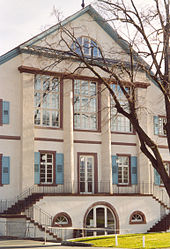Stephanienbad
The Stephanienbad ( now also known as the Paul Gerhardt Church ) is a classicist building by the master builder Friedrich Weinbrenner from Karlsruhe and is located in the Beiertheim district . It was built between the years 1811-1817.
history
Construction of the first bathing house on the Alb began as early as 1780 . However, the building was more of a temporary measure and only partially suitable as a bathing establishment. The writer Johann Peter Hebel was one of the guests at the time . Due to the dilapidation of the old house, the construction of a public building with a bathing area began in 1811. In addition, a small garden in the style of an English garden was laid out behind the building . After the construction was completed, it was named after Grand Duchess Stephanie de Beauharnais . The building was then used both as a bathing house and as a social building for various events, which was accompanied by multiple changes of ownership. Since neither of the owners was granted success, the building slowly fell into disrepair. Ultimately, it was converted into a tenement house.
In 1880 the house found a new owner who reactivated the old bathhouse and made it accessible to the general public. From 1903 the building was converted into the first Karlsruhe air bath . The time for air and sunbathing was only short, however, as in 1905 the course of the nearby and water-donating Alb was changed in order to build a railway embankment for the new Karlsruhe main station . Due to these circumstances, the swimming pool had to be stopped. Only the society house was managed. By the First World War, the building had gained national fame, as student associations held their forbidden courses there. In 1944 the building was badly damaged by an air raid . After the end of the war, there was long discussion about whether the building should be rebuilt. After the majority of the community campaigned for the reconstruction, this was completed by 1957.
Todays use
As early as 1926, the Protestant parish of Karlsruhe rented the society house and used it for regular events. The former Stephanienbad has been used as a church building by the evangelical Paul Gerhardt congregation since 1957. In the course of this change of use, the former bathhouse was renamed the Paul Gerhardt Church. The church is named after the Saxon theologian and poet Paul Gerhardt .
organ
There is an extraordinary organ in the left aisle . The instrument was built in 2004 by the organ building company Waldkircher Orgelbau Jäger & Brommer . The pipework is encased in a general sill made of glass . The housing cube appears light and transparent. The glass of the swell system weighs a total of 650 kg; the sill is operated electrically by means of a kick. The slider chest instrument has 19 stops (including two pre-prints) on two manual works and a pedal. The playing and stop actions are mechanical.
|
|
|
|||||||||||||||||||||||||||||||||||||||||||||||||||||||||||||||||||||||
- Coupling : II / I, II / II (sub-octave coupling), I / P, II / P
literature
- Birgit Sauer-Löffler: A new life is going on here. Stephanienbad - Paul-Gerhardt-Parish. 175 years of history of a house. Self-published, without location, 1987
- Paul-Gehar: Reconstruction of the Stephanienbad Karlsruhe. 1997
Web links
- The building on the side of the city of Karlsruhe
- Information about the history of the building can be found on the website of the Beiertheim Citizens' Association
- The Paul Gerhardt congregation on the website of the Protestant Church Karlsruhe ( Memento from February 25, 2014 in the Internet Archive )
Coordinates: 48 ° 59 ′ 27.2 " N , 8 ° 23 ′ 32.3" E



